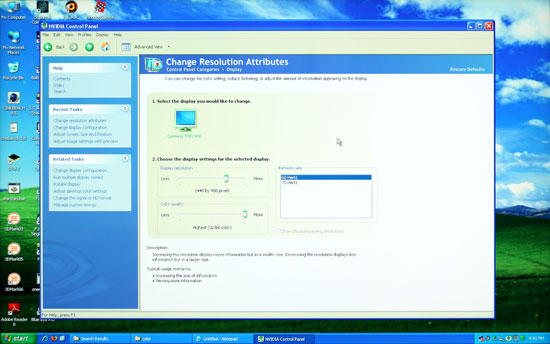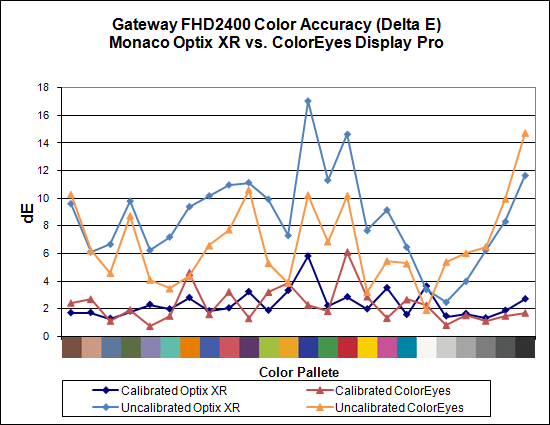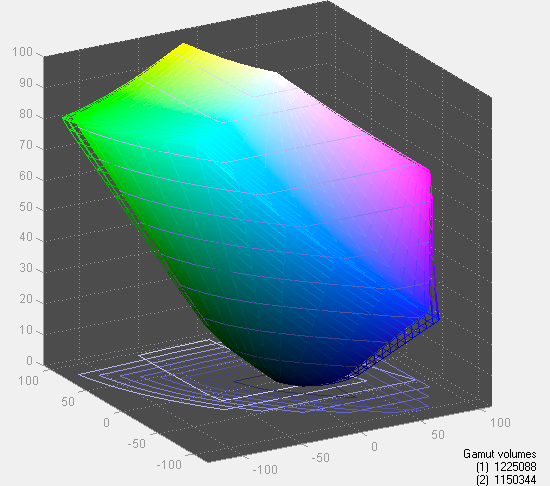Gateway FHD2400 Evaluation
The Gateway OSD remains largely unchanged since last Gateway LCD we reviewed -- the Gateway FPD2485W. It worked well over a year ago and it continues to work well today. Gateway uses a touch-sensitive buttons system on the right side of the LCD, but rather than leaving you to guess where to press, all of the active buttons light up as soon as you press the menu button. Our only complaint is that there are areas where Gateway could make better use of the buttons.
As an example, when you first activate the menu there are six buttons plus an additional two buttons up top that cycle through the color presets. These six buttons allow you to jump directly to one of several areas. Once you enter the Main menu, however, you then have to use the top two buttons to move up and down with the third button functioning as a select key. Granted, there are eight options in the main menu, but two of these (Auto and Reset) could easily be moved to a submenu. As a whole, though, this is a minor complaint on an OSD setup that works well.
Gateway includes seven color presets, one of which is "User" and allows manual adjustment of the color levels. Gateway also includes support for RGB and YUV color spaces. Also of interest is the "UltraResponse" function that supposedly improves pixel response times -- not that we could really tell. Gateway claims 3ms with UltraResponse enabled versus 5ms without UltraResponse.
The FHD2400 has four aspect ratio options: Wide, Zoom, 1:1, and Panoramic. "Panoramic" scaling only shows up with component (and perhaps other analog video connections), but then it just seems to do the same thing as "Wide". "Wide" fills the entire LCD with your current resolution, while "Zoom" fills the height or width while maintaining the correct aspect ratio. "1:1" is again a direct-mapped mode without any stretching. Here's a summary of our resolution testing:
| Gateway FHD2400 Resolution and Input Notes | ||||
| Component | DVI | HDMI | VGA | |
| 800x600 | Yes | Yes | Yes | |
| 1024x768 | Yes | Yes | Yes | |
| 1152x864 | Yes | Yes | Yes | |
| 1176x664 | Underscanned 720P | - | Underscanned 720P | - |
| 1280x720 | Yes | Yes | Yes | Yes |
| 1280x768 | Yes | Wrong AR (1280x1024) Use "Zoom" scaling |
Yes | |
| 1280x800 | - | Wrong AR (1280x1024) Use "Zoom" scaling |
- | |
| 1280x960 | Yes | Yes | Yes | |
| 1280x1024 | Yes | Yes | Yes | |
| 1400x1050 | - | Yes | - | |
| 1440x900 | Yes | Yes | Yes | |
| 1600x1200 | Yes | Wrong AR Always fills LCD ("Zoom") |
Yes | |
| 1680x1050 | Yes | Yes | Yes | |
| 1768x992 | Underscanned 1080i | - | Underscanned 1080P | - |
| 1920x1080 | Too much flicker | Yes | Yes | Yes |
| 1920x1200 | - | Yes | Yes | Yes |
First, let's get this out of the way: the component connection is only really suitable for 720P or 1080i signals. In general, the 720P option looks much better -- the opposite of the 2408WFP when using a component connection. All resolutions with more than 720 scanlines show severe flicker on component, as they run 60Hz interlaced. The other tested input options all work much better. VGA and DVI achieve a perfect score on all of the available resolutions, with no scaling abnormalities. Also worth mentioning is that the "Auto adjust" function on VGA is very fast. HDMI input has a few errors that you can work around by manually selecting "Wide" scaling; only 1600x1200 as an uncorrectable error in that it always fills the entire LCD, regardless of what scaling mode you choose.
 |
Running at non-native resolution, the FHD2400 does well at scaling the image to fit the panel and there are no serious artifacts. Obviously, 1920x1200 is still the optimal setting, but if you need to play a game or watch a movie at a lower resolution, you shouldn't have any complaints.


Besides limited viewing angles -- which are a problem on all TN panels today -- the one sticking point with the Gateway FHD2400 is color accuracy. After calibration, it achieves an average Delta E of only 2.3, which puts it in last place among tested LCDs. Uncalibrated color accuracy is also quite poor, coming in at 8.6 with plenty of colors above 10.0. Imaging professionals will almost certainly want something better. The good news is that the color gamut is good, achieving over 95% of the Adobe RGB 1998 standard.
The Gateway FHD2400 is sort of the opposite of the Dell 2408WFP. The Dell offers the absolute worst input lag but has by far and away the best color accuracy. The FHD2400 doesn't suffer from input lag at all, but unfortunately it has some of the worst color accuracy among tested LCDs. It's still a beautiful looking LCD, and it gets so many things right that we have no qualms recommending it to non-imaging professionals. That goes double if you'd like glossy LCD panels.
















89 Comments
View All Comments
AnnonymousCoward - Friday, May 16, 2008 - link
I agree with Jarred on both accounts: you can't go wrong with the LP3065 or 3007WFP-HC, and input lag is far less than the lag time you experienced on the tablet. But if you're really sensitive to it, I'd avoid the Dell 2708, Dell 3008, Samsung 244T, and Samsung 245T, as those seem to have the worst lag of all.For unbeatable 24" color accuracy, the choice is obvious: NEC LCD2490WUXi (U.S.) or Hazro HZ24W (U.K.). I think they have mid-range lag (35ms?), which you probably wouldn't notice. The LP3065, 3007, and DoubleSight 26" are high quality IPS screens with very little lag, and for professional animation work, why not go bigger than 24"?
AnnonymousCoward - Sunday, May 11, 2008 - link
Jarred, I'm glad to see input lag drawing so much attention. You seem well aware of this, but I wanted to point out that the LP3065 was a poor choice for a reference monitor. It likely performs the same as the 3007-HC, which has measurements that bounce from 0-20ms; 3 increments on your scale (maybe 2 considering refresh rate). Some LCDs out there consistently measure close to 0ms.The editor's comments are completely out of context! ("They're huge, heavy, and require more power, and the best ones were made over five years ago. Sorry - LCDs are where everything is heading.") A heavy, power hungry, old, and obsolete 15" CRT would still be an ideal reference.
JarredWalton - Tuesday, May 13, 2008 - link
It would probably be a faster reference, but I'm not going to try to dig one up. Sorry. My place is crowded enough without keeping around an obsolete CRT. I sold off a couple 19" CRTs two years ago, and that was the last time I had one around for testing. I had to junk my old 21" CRT (from 1997) because I couldn't even give it away. 85 pounds now at the junk pile.As it stands, I will continue to use the LP3065 as a reference LCD. If I test an LCD that scores better than the LP3065, that's not a problem: it will have a negative "relative input lag" score. A CRT might very well score 20ms faster; my problem isn't with 0ms vs. 20ms (assuming CRTs can score 0ms); it's with 0ms vs. 60ms and perhaps 0ms vs. 40ms.
Personally, I'm certainly fine with the LP3065 - it is in use on my own gaming system and I've never been bothered with any discernible input lag. Image tearing caused by turning off VSYNC is a much bigger concern -- and that's one area where I'd like to see LCDs improve; a 120Hz refresh rate would help a lot. But then we'd need all new graphics cards and connectors to manage the data rates for 120Hz at 2560x1600.
AnnonymousCoward - Friday, May 16, 2008 - link
I hear ya on CRTs being too big to keep around :)I thought your measurements would have more variation, like by 40ms, since in many lag tests I've seen, measurements varied by 20ms. But your variations were 20ms, including both the reference and the one tested. I'd have to agree that a CRT isn't necessary, since the variations are under control (but I'll still add 11ms to the final numbers, as you've talked about). I'm surprised your 245T results weren't higher.
I have a 3007-HC and agree about the excessive tearing. And of course if the framerate can't stay above 60, I have to disable vsync and live with it. You gotta admit, it's quite nice that the 8800-series cards came out within a year of the 30"ers, and that those two separate technologies complement each other.
I wonder why the DoubleSight is going EOL, if it's such a great monitor and hot seller! Does that indicate customer return problems?
ShocWave - Wednesday, May 7, 2008 - link
Actually, I have a 2493HM.AV mode will display 720p and 1080p at the correct aspect ratio with overscan. What it basically does is fill the screen and crops out the sides.
It's not 1:1, but better then nothing.
JarredWalton - Wednesday, May 7, 2008 - link
I just don't understand why anyone would *want* overscan. AV Mode takes 720p stretched to fill the whole screen and then overscans it, right? Or are you saying it only crops the left and right sides? (I suppose I could check if I dig the LCD back out.)I'm not a stickler on aspect ratios, especially 16:9 stretched to fit 16:10 - the information is merely listed for those who really do care. I still think the Gateway has a better approach and overall better design. The Samsung however offers better color accuracy and a non-glossy panel for the same price. It's a close second in the TN panel contest (out of tested LCDs).
10e - Saturday, May 10, 2008 - link
Yes, that's exactly what it does. Takes the 720p/1080p image and "zooms" it so that it fills the screen vertically, but gets cut off at the sides. So you have a 16:10 "window" looking at a 16:9 screen that is missing some of the image left and right (about 5%)I use an image from the "TigerDave" site that shows exactly the amount of 720p and 1080p overscan a display will suffer. It does actually cut off a very small part of the image top and bottom as well.
I don't know what Samsung had in mind here. The newer revisions of the 245T and 275TPlus have a built in image setting for 16:9 now that supposedly works, so why they couldn't fix this in a technically newer design (2493HM) is confusing.
BattleRattle - Wednesday, May 7, 2008 - link
Do input lag against a CRT... Its the analog of the CRT that mattersviperboy2025 - Tuesday, May 6, 2008 - link
How does this compare to other reputable LCD monitors, I can't help but think anandtech is commercializing Dell displays. I mean how about the profesional serious from viewsonic, VP2650wb. They don't have a 24" oddly, but they do have a 26", VP2650wb, at a similar price as the dell 24", costing $615 at onsale.com with free shipping at the moment.The specs of this monitor seem to be better at everything than the dell, as it has 26" (compare to 24"), same resolution, 3ms response time, same 110% color gamut, 4000:1 contrast ration (compare to 3000:1), only difference I see are the inputs, since the professional serious doesn't carry TV inputs. But viewsonic does has a line of the X serious, all of which have hdmi, component, composite, and s video components, which i even doubt most people would use anyways since they would be attaching this to a computer not using it as a TV.
JarredWalton - Tuesday, May 6, 2008 - link
Drop contrast ratio and response time from that list, as they are meaningless figures. Color accuracy with "dynamic contrast" is horrible on all the displays I've tested - you can see the screen get darker/brighter as you watch, and I find it extremely distracting. So what you end up with is a 26" display at a good price. Is it better or worse than the Dell? In color accuracy, I'd bet a lot of money that it's worse without calibration.For the record, Dell displays are already "commercialized". The only thing wrong with the 2408WFP that I can see is input lag. I made this quite clear. If you're looking for a good 24" LCD for professional work, I'd recommend it without reservation. If you want a gaming LCD, probably look around more.
I can't review every LCD out there, in part because most companies don't send us samples. Viewsonic is one of those companies (I've emailed them at least six times in the past year without a single response). They can call something a "professional display" if they want, but that doesn't make it any more true than the "get rich quick" schemes you see floating around. It may or may not be a great LCD; I'd love to get one sent here for review. Note also that all it took was one email to LaCie and they jumped at the opportunity for this review. If you're looking for a true professional display and you want great support, I'd recommend them in a heartbeat. $300 more is a tough pill to swallow for casual use, but for professionals that should be a non-issue.